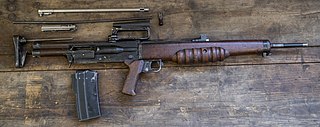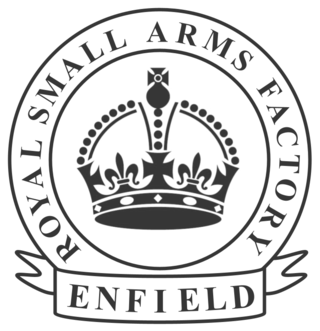
Enfield L67A1 is an 1.5-inch breech-loading riot gun prototype produced at the Royal Small Arms Factory (RSAF) in Enfield, Britain.

Enfield L67A1 is an 1.5-inch breech-loading riot gun prototype produced at the Royal Small Arms Factory (RSAF) in Enfield, Britain.
The L67A1 prototype was developed at RSAF Enfield as part of an experimental programme to explore new designs for riot control weapons. It was produced in the early stages of this development and was part of a broader effort to advance non-lethal crowd control technology.
The L67A1 features:
The weapon was designed as a breech-loading system, allowing for potentially rapid reloading and versatile use in crowd control scenarios. Its design included a rifled barrel liner to improve accuracy.
The Enfield L67A1 was produced in 1988 by RSAF Enfield. [2]

The SA80 is a British family of 5.56×45mm NATO service weapons used by the British Army. The L85 Rifle variant has been the standard issue service rifle of the British Armed Forces since 1987, replacing the L1A1 Self-Loading Rifle. The prototypes were created in 1976, with production of the A1 variant starting in 1985 and ending in 1994. The A2 variant came to be as the result of a significant upgrade in the early 2000s by Heckler & Koch and remains in service as of 2023. The A3 variant was first issued in 2018 with several new improvements.

Bolt-action is a type of manual firearm action that is operated by directly manipulating the bolt via a bolt handle, most commonly placed on the right-hand side of the firearm. The majority of bolt-action firearms are rifles, but there are also some variants of shotguns and handguns that are bolt-action.

The Lee–Enfield is a bolt-action, magazine-fed repeating rifle that served as the main firearm of the military forces of the British Empire and Commonwealth during the first half of the 20th century, and was the standard service rifle of the British Armed Forces from its official adoption in 1895 until 1957.

The STEN is a British submachine gun chambered in 9×19mm which was used extensively by British and Commonwealth forces throughout World War II and during the Korean War. The Sten paired a simple design with a low production cost, facilitating mass production to meet the demand for submachine guns.

The Bren gun was a series of light machine guns (LMG) made by Britain in the 1930s and used in various roles until 1992. While best known for its role as the British and Commonwealth forces' primary infantry LMG in World War II, it was also used in the Korean War and saw service throughout the latter half of the 20th century, including the 1982 Falklands War. Although fitted with a bipod, it could also be mounted on a tripod or be vehicle-mounted.

A grenade launcher is a weapon that fires a specially designed, large-caliber projectile, often with an explosive, smoke, or gas warhead. Today, the term generally refers to a class of dedicated firearms firing unitary grenade cartridges. The most common type are man-portable, shoulder-fired weapons issued to individuals, although larger crew-served launchers are issued at higher levels of organization by military forces.

The Webley Revolver was, in various designations, a standard issue service revolver for the armed forces of the United Kingdom, and countries of the British Empire and the Commonwealth of Nations, from 1887 to 1970.

The Martini–Henry is a breech-loading single-shot rifle with a lever action that was used by the British Army. It first entered service in 1871, eventually replacing the Snider–Enfield, a muzzle-loader converted to the cartridge system. Martini–Henry variants were used throughout the British Empire for 47 years. It combined the dropping-block action first developed by Henry O. Peabody and improved by the Swiss designer Friedrich von Martini, combined with the polygonal rifling designed by Scotsman Alexander Henry.

Webley & Scott is an arms manufacturer founded in Birmingham, England. Webley produced handguns and long guns from 1834 to 1979, when the company ceased to manufacture firearms and instead turned its attention to producing air pistols and air rifles. In 2010 Webley & Scott restarted the production of shotguns for commercial sale.

The Sterling submachine gun is a British submachine gun (SMG). It was tested by the British Army in 1944–1945, but did not start to replace the Sten until 1953. A successful and reliable design, it remained standard issue in the British Army until 1994, when it began to be replaced by the L85A1, a bullpup assault rifle.

The ARWEN 37 is a less-lethal launcher which fires a variety of 37mm less-lethal munitions which includes direct impact batons, chemical irritant delivery munitions and smoke delivery munitions. The ARWEN 37 has 5-round rotary drum magazine.

The EM-2, also known as Rifle, No.9, Mk.1 or Janson rifle, was a British assault rifle. It was briefly adopted by British forces in 1951, but the decision was overturned very shortly thereafter by Winston Churchill's incoming government in an effort to secure NATO standardisation of small arms and ammunition. It was an innovative weapon with the compact bullpup layout, built-in carrying handle and an optical sight.

The Royal Small Arms Factory (RSAF), also known by the metonym Enfield, was a UK government-owned rifle factory in Enfield, adjoining the Lee Navigation in the Lea Valley. Some parts were in Waltham Abbey. The factory produced British military rifles, muskets and swords from 1816. It closed in 1988, but some of its work was transferred to other sites.

The L21A1 RARDEN is a British 30 mm autocannon used as a combat vehicle weapon. The Royal Armament Research and Development Establishment (RARDE) and the Royal Small Arms Factory (RSAF), were part of the Ministry of Defence, at the time.
The Pattern 1913 Enfield (P'13) was an experimental rifle developed by the Royal Small Arms Factory for the British Army as a result of its combat experience in the Second Boer War from 1899 to 1902. The weapon was to serve as a replacement for the Short Magazine Lee–Enfield (SMLE). An advanced chamber design allowed for a high-velocity .276 Enfield rimless round, which was more powerful than the service-issued .303 British cartridge. Introduction of the P'13 was rendered impractical by the outbreak of the First World War.
The British .577 Snider–Enfield was a breech-loading rifle. The American inventor, Jacob Snider created this firearm action, and the Snider–Enfield was one of the most widely used of the Snider varieties. The British Army adopted it in 1866 as a conversion system for its ubiquitous Pattern 1853 Enfield muzzle-loading rifles, and used it until 1880 when the Martini–Henry rifle began to supersede it. The British Indian Army used the Snider–Enfield until the end of the nineteenth century.

The origins of the modern British military rifle are within its predecessor the Brown Bess musket. While a musket was largely inaccurate over 100 yards (91 m), due to a lack of rifling and a generous tolerance to allow for muzzle-loading, it was cheap to produce and could be loaded quickly. The use of volley or mass firing by troops meant that the rate of fire took precedence over accuracy.

Martini–Enfield rifles were, by and large, conversions of the .577/450 Martini–Henry rifle, rechambered for use with the newly introduced .303 British cartridge. Whilst most Martini–Enfields were converted rifles, a number were newly manufactured as well.
Royal Ordnance Factory (ROF) Nottingham opened in 1936 in The Meadows, Nottingham, United Kingdom. It was one of a number of Royal Ordnance Factories created in the build up to World War II. During the war the site employed up to four thousand workers. The factory was closed in 2001.

The Enfield No. 2 was a British top-break revolver using the .38 S&W round manufactured from 1930 to 1957. It was the standard British/Commonwealth sidearm in the Second World War, alongside the Webley Mk IV and Smith & Wesson Victory Model revolvers chambered in the same calibre. Note that in the context of British service revolvers, the .38 S&W cartridge has often been called ".380".